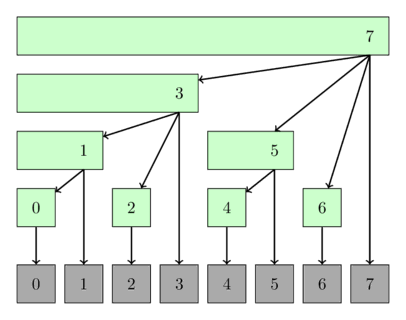Binary Indexed Tree (Fenwick Tree)
What is a Binary Indexed Tree
Binary Indexed Tree is a data structure that can store array of length with following property
- Calculates the value of function in the given range in time. There are some restriction on which kind of function you can use, for example sum function works, but min/max function don't.
- Updates the value of an element of in time
- Requires only spaces, which is the input spaces
Why do we need it
Naive calculation of in the range usually cost . Imagine you have queries, each of them traverse through an array length , you would end up having 10 billions traversal and TLE.
How it works
Here is an example of a BIT representation for an array of 8 items
<center>
 <small>(image taken from cp-algorithms.com)</small>
<small>(image taken from cp-algorithms.com)</small>
</center>
In this example, let be the original array and be the BIT version of . Let be the sum function for the sake of simplicity.
Here is the process to calculate
- Start with , covers only , we add the the final result
- Next, we want to go to the next uncovered range, which is , covers , we add to the final result
- Next uncovered range, . covers . Add to the final result. We end here because we have covered the range .
What if you want to calculate
- Start with , covers , we add to the final result
- Next, we want to go to the next uncovered range, which is . covers . Add to the final result and we are done.
What if you want to calculate
- Start with , Luckily enough, covers so we already got the answer, which is
Definition of
The computation of is defined using the following simple operation: we replace all trailing 1 bits in the binary representation of with 0 bits.
In other words, if the least significant digit of in binary is 0, then . And otherwise the least significant digit is a 1, and we take this 1 and all other trailing 1s and flip them.
There exists a simple implementation of using bitwise operator as follow
Example of
It means will be covering
It means will be respectively covering only
C++ implementation
BIT 1D
struct FenwickTree {
vector<int> bit; // binary indexed tree
int n;
FenwickTree(int n) {
this->n = n;
bit.assign(n, 0);
}
int sum(int r) {
int ret = 0;
for (; r >= 0; r = (r & (r + 1)) - 1)
ret += bit[r];
return ret;
}
int sum(int l, int r) {
return sum(r) - sum(l - 1);
}
void add(int idx, int delta) {
for (; idx < n; idx = idx | (idx + 1))
bit[idx] += delta;
}
};
BIT 2D
struct FenwickTree2D {
vector<vector<int>> bit;
int n, m;
// init(...) { ... }
int sum(int x, int y) {
int ret = 0;
for (int i = x; i >= 0; i = (i & (i + 1)) - 1)
for (int j = y; j >= 0; j = (j & (j + 1)) - 1)
ret += bit[i][j];
return ret;
}
void add(int x, int y, int delta) {
for (int i = x; i < n; i = i | (i + 1))
for (int j = y; j < m; j = j | (j + 1))
bit[i][j] += delta;
}
};
Learn more
See this for more detailed explaination: https://cp-algorithms.com/data_structures/fenwick.html